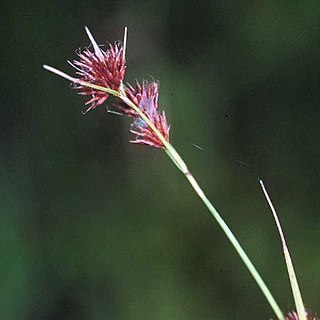Perennials, more rarely annuals. Stems usually tufted, rarely solitary, erect, more or less trigonous, sometimes almost terete. Leaves linear, basal or also cauline, flat or canaliculate; ligule absent; sheaths of the cauline leaves long, at the orifice sometimes with a short scarious appendage opposite the leaf-blade. Inflorescence capitate, spike-like, or paniculate (in the last case consisting of a terminal and some axillary corymbiform anthelas). Bracts leafy. Spikelets solitary or in clusters, lanceolate or oblong-lanceolate, terete or flattish, sessile or peduncled, usually few-flowered. Rachilla straight, sometimes anfractuose. Glumes 5-8, spiral or subdistichous, imbricate, 1-nerved, the lower 3-4 empty, shorter than the upper fertile ones. Flowers bisexual, or lowest flower bisexual, fertile, the upper ones ♂ or sterile, or lowest flowers ♀, upper one(s) ♂. Perigone consisting of 3-6 (rarely more) rigid or delicate bristles, more rarely absent. Stamens (1-)2-3; filaments ligulate; anthers linear, with shortly produced connective, sometimes with a short, narrowed sterile basal part. Style slender, articulated with the ovary, almost undivided to deeply bifid, dark brown, dilated at the base. Style-base (or even the greater part of the style) persistent on the nut, clearly distinct from the latter, compressed-conical, subulate, or semilunar. Nut sessile or shortly stipitate, 2-sided, obovate, elliptic, or oblong, (in the Malesian spp.) smooth or transversely rugulose, papillose, setulose, or glabrous.
Herbs, perennial or more rarely annual. Culms tufted, erect, 3-angled or terete. Leaves basal or cauline; sheath closed, with or without a ligule; leaf blade linear, flat or canaliculate. Involucral bracts leaflike, sheathing. Inflorescences paniculate, usually consisting of terminal and lateral anthelae, sometimes spicate or capitate. Spikelets sessile or pedunculate, narrowly ovoid, ovoid, or ellipsoid, slightly bilaterally compressed or terete. Glumes few to many, spirally imbricate or rarely distichous, 1-veined; basal 3 or 4 glumes shorter than apical ones and empty. Flowers bisexual or basal flower bisexual and apical one male or sterile. Perianth bristles 0-6(-13), antrorsely or retrorsely scabrous, rarely smooth. Stamens 2 or 3. Style slender; stigmas 2. Nutlet usually obovoid to ovoid, biconvex, with various ornamentations or more rarely smooth; persistent style base thickened, mostly conic or rarely lunate, spongy, base truncate or ± lobed.
Spikelets several to many, cymosely (or in part subumbellately) arranged in leafy-bracteate, open to congested infls, often forming 1– several dense glomerules; scales spirally imbricate, sometimes each subtending a fl, but more often the lower empty and only 1–few of the upper ones subtending fls; fls perfect or some of them staminate; perianth of (1–)6(–20) bristles, or sometimes wanting; stamens (1–)3; style bifid, its expanded base (tubercle) enlarged at maturity and persistent on the lenticular achene; our spp. mostly perennial (2 spp. annual), with ± leafy (seldom lfless), often trigonous stems and narrow, grass-like lvs with closed sheath. (Dichromena, Psilocarya) 200+, chiefly of warm regions.
Plants mostly perennial, sometimes annual, the culms 3-angulate or terete; spikelets oblong or fusiform, variously arranged, the scales 1-nerved, spirally imbricate; upper flowers staminate, the lower perfect; perianth of bristles, or sometimes wanting; stamens usually 3; style 2-cleft or rarely entire; achene lenticular or turgid, smooth or transversely rugose, capped by the persistent style base.

